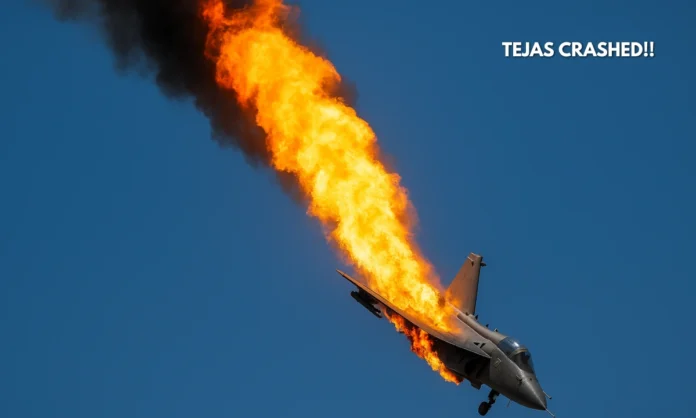Key Highlights:
- Tejas fighter jet crashed at Dubai Air Show during a low-altitude aerobatic maneuver.
- Wing Commander Namansh Syal, the pilot, died in the accident.
- The crash occurred during a negative G turn followed by a roll, resulting in loss of altitude and control.
Tejas Fighter Jet Crash: Opening Overview
The Tejas fighter jet crash at the Dubai Air Show has captured global attention with new photos revealing the aircraft descending and engulfed in flames before impact. The single-seat Light Combat Aircraft (LCA) was performing a high-risk aerobatic maneuver involving a negative G turn, which caused a rapid loss of altitude. The pilot, Wing Commander Namansh Syal, lost control resulting in the fatal crash.
This incident marks a tragic moment for India’s indigenous fighter aircraft program. The Tejas fighter jet crash has raised urgent questions about flight safety and operational challenges during demonstration flights. With the focus keyword “Tejas fighter jet crash” appearing prominently in this report, the narrative explores the technical aspects, pilot background, and broader aviation safety context tied to this event.
दुबई एयर शो में भारत का Tejas क्रैश—एक वीर पायलट शहीद।
— बातें यूपी की (@batenupki) November 22, 2025
एरोबेटिक फ्लाइट के दौरान विमान अचानक नियंत्रण खो बैठा और कुछ ही सेकंड में आग का गोला बनकर रनवे के पास गिर गया।
देश आज अपने इस आकाशवीर को सलाम करता है।#TejasCrash #IAF #DubaiAirShow #BaatenUPKi pic.twitter.com/YpwkMAO2jm
Aerobatic Maneuvers and Negative G Forces
- Negative G forces act opposite to normal gravity, creating intense strain on pilots and aircraft.
- The Tejas was executing a negative G turn followed by a barrel roll at very low altitude before crashing.
Negative G maneuvers in aviation are forces acting against the normal direction of gravity, typically during sharp turns or sudden descent. These forces can cause disorientation or loss of consciousness if not properly managed by pilots. The Tejas fighter jet crash involved such a maneuver where the aircraft went into a negative G turn and then transitioned to a roll. Flying extremely close to the ground limited altitude for recovery. Although the aircraft managed to level its wings post-roll, its vertical speed downward was too high, leading to impact with the ground. Understanding these physical forces clarifies the inherent risks of low-altitude aerobatic displays and underscores pilot skill requirements for safely handling such conditions.
Pilot Profile: Wing Commander Namansh Syal
- Wing Commander Namansh Syal was a 34-year-old officer with a decade of experience in the Indian Air Force.
- He hailed from Himachal Pradesh and was part of the Sulur Air Force Station.
Wing Commander Namansh Syal was a respected Indian Air Force pilot with a record of disciplined service. A native of Kangra district in Himachal Pradesh, he completed his schooling at Sainik School, Sujanpur Tira, and was commissioned into the IAF in 2009. He served at the Sulur Air Force Station before deputation for the Dubai Air Show. Syal is survived by his wife, an IAF officer, their young daughter, and his parents. His dedication to service and piloting skill highlights the human loss behind the Tejas fighter jet crash, adding a personal dimension to this tragic event.
Aviation Safety and the Tejas Program
- The Tejas crash is one of the rare fatal accidents in the Indian indigenous fighter jet program.
- Aviation safety remains a critical focus amid increased operational risks during complex aerobatic demonstrations.
Globally, 2025 has been noted as a difficult year for civil and military aviation safety, with a rise in fatal incidents. The Tejas fighter jet crash is the second fatal accident involving this aircraft model and the first involving loss of the pilot’s life. The incident emphasizes ongoing challenges in developing and deploying indigenous aircraft in demanding operational scenarios. The Indian Air Force has launched a formal inquiry to investigate all technical and procedural details. This event has sparked discussions on the balance between showcasing advanced fighter capabilities and ensuring pilot safety, particularly during high-risk display maneuvers at international air shows.
Closing Assessment
The Tejas fighter jet crash at the Dubai Air Show remains a solemn reminder of the risks military aviators undertake to demonstrate aerial prowess. The tragic loss of Wing Commander Namansh Syal marks a significant moment for India’s defense aviation community. Examining the details of the negative G turn and subsequent roll underlines the precision required in aerobatics and the high stakes involved.
As investigations continue, the focus will likely turn to integrating lessons learned into pilot training and aircraft operational protocols. The incident also highlights the critical need for robust safety margins during live demonstrations to prevent future tragedies. The Tejas fighter jet crash will resonate as an urgent call for advances in both technology and human factors in military aviation.


